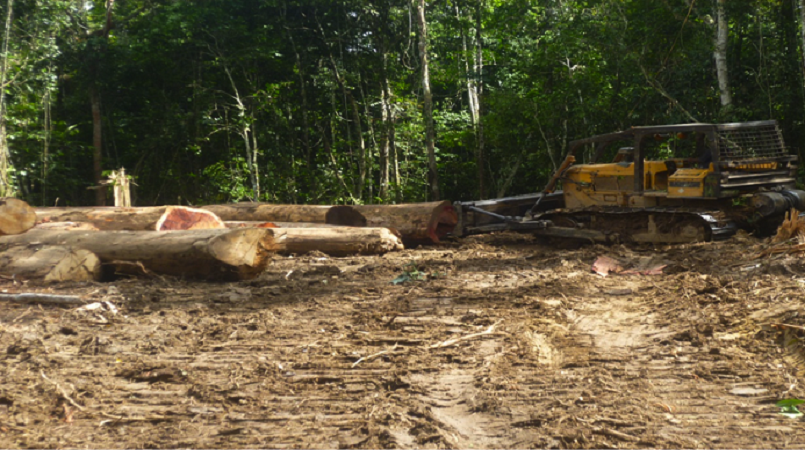
In 2014, Papua New Guinea became the world’s largest exporter of tropical timber. This wasn’t supposed to happen.
Eleven years ago, PNG formed the Coalition for Rainforest Nations and presented the idea of REDD to the UN climate meeting in Montreal.
The architect of REDD, Kevin Conrad, completed his MBA in International Finance at Columbia University in 2005. For his final MBA project, Conrad looked at whether the money from carbon credits could be as profitable as logging in Papua New Guinea. He decided that it could.
In a November 2005 piece for the Financial Times, Conrad and his supervisor at Columbia Geoffrey Heal, wrote that, “Recognising carbon credits from avoiding deforestation makes standing timber an income-earning asset worthy of conservation.”
How things have gone so terribly wrong is documented in a new report by Frederic Mousseau, published by the Oakland Institute: “The Great Timber Heist: The Logging Industry in Papua New Guinea“.
The report makes no mention of REDD. Instead it reports how the logging industry is destroying PNG’s forests. In 2014, 3.8 million cubic metres of timber was exported. REDD has done nothing to stop this destruction.
5.5 million hectares of Special Agriculture and Business Leases
The exploitation of PNG’s forests has accelerated in recent years with the issuing of a total of 5.5 million hectares of Special Agriculture and Business Leases. Rather than being used for agricultural projects, as originally intended, SABLs have been widely used by logging companies. In 2013, PNG’s Prime Minister Peter O’Neill said that a Commission of Inquiry into the SABLs, “revealed a shocking trend of corruption and mismanagement in all stages in the process”.
In June 2014, O’Neill promised to cancel all illegal deals. But the government has taken no meaningful action to cancel deceptive land deals, stop illegal logging, or return land to traditional owners.
10 million hectares of logging concessions
In addition to SABLs, the government has issued 10 million hectares of logging concessions. In 2013, the Oakland Institute produced a film about the impacts of logging on communities in PNG.
Rimbunan Hijau’s 40 years of destruction
The report focusses on subsidiaries of Rimbunan Hijau, the largest logging company in PNG. Rimbunan Hijau was founded by Tiong Hiew King in 1976 as a logging company in Malaysia. Having devastated Malaysia’s forests, the company and its subsidiaries expanded operations to Papua New Guinea, Indonesia, the Solomon Islands, Vanuatu, Burma, Gabon and Equatorial Guinea.
The report reveals rampant transfer pricing in the logging industry in PNG, where companies underprice exported timber and overprice expensive for goods and services in PNG. As a result:
Most of the logging industry appears to declare little to no profit from the export of timber.
The 16 subsidiaries of the Malaysian firm Rimbunan Hijau Group investigated in this report appear to have been working mostly at loss for over a decade.
With no or little profit declared, most of the companies in the sector generally don’t pay the 30% income tax on profit that businesses are required to pay according to national laws. Operating at a loss, the 16 RH subsidiary companies we investigated have together accumulated around $32 million in tax credit in just seven years.
The discrepancies found in PNG timber export prices and the operational losses declared by many logging companies seem to indicate that transfer pricing is taking place in PNG’s forest industry—resulting in a loss of tax revenue that may exceed $100 million per year.
One of the ways that companies can give the appearance of reduced profits is by using multiple companies and subsidiaries, including holding companies in tax havens. The majority of Rimbunan Hijau holding companies are in the British Virgin Islands, including: Super Acme Ltd., Mooningham Ltd., Wilmington Co. Ltd., Subang Inc., and Proexcel Ltd.
The Malaysia Insider reports that Rimbunan Hijau responded by calling the report “baseless and inaccurate”, and called it an attack by “western anti-forestry activists”.
But Rimbunan Hijau’s destructive logging activities have been going on way too long. Eleven years ago, Greenpeace put out a report titled, “Rimbunan Hijau Group – Thirty Years of Forest Plunder“.
And as the Oakland Institute’s 2013 film documents, it is the people of PNG who are suffering the impacts of the logging industry.
The parallel universe of REDD
On the same day that the Oakland Institute released its new report, the UNDP put out a press release.
Needless to say, the press release makes no mention of what to do about PNG’s 5.5 million hectares of Special Agriculture and Business Leases, or the country’s 10 million hectares of logging concessions. It also does not mention Rimbunan Hijau.
Nor does it mention that the World Bank’s Carbon Fund has said that it will not pay more than US$5 per REDD credit. Back in 2005, when Heal and Conrad were writing about REDD making standing timber an “income-earning asset”, they assumed a price of US$25.
